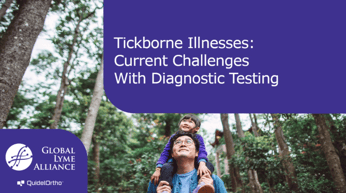
By Jane M. Caldwell, Ph.D. – Executive Director, Medavera Inc., Springfield, MO and Elizabeth Lee-Lewandrowski, Ph.D., MPH - Assistant Professor, Harvard Medical School, Department of Pathology, Massachusetts General Hospital, Boston
Disclosure: Dr Lewandrowski has received research support from Quidel
You went on a late summer hike and took all the recommended precautions to prevent tick bites: long sleeves, broad-brimmed hat, light-colored clothing, tucked pants into socks, tucked shirt into pants, and sprayed yourself liberally with DEET. You stuck to the trail, avoiding tall grass and low bushes. But when you got home and stepped into the shower, you noticed an itch behind your knee. When you reached down to scratch, you felt a teeny, tiny bump – a nymphal tick, smaller than a sesame seed!
Now what?
With a tick bite, time is of the essence for preventing the spread of Borrelia burgdorferi, the bacteria that causes Lyme Disease (LD). Here’s the good news: there are tests which can provide rapid results. Rapid tests can be performed in a clinical laboratory or at the point-of-care (POC) in the physician’s office or urgent care clinic. ‘Rapid’ refers to a technology whereas ‘POC’ refers to a location. According to Dr. Elizabeth Lee-Lewandrowski, Assistant Professor at Harvard Medical School, “The Centers for Disease Control (CDC) define Lyme disease as a clinical diagnosis [based on a patient’s history and symptoms] which may be supported by serological testing. Physicians should treat the patient if the clinical picture fits the diagnosis. Rapid testing can be ordered as a baseline measurement initially, then follow-up testing after 10 to 14 days to see if any antibodies are detected by the test. Doctors can reference the testing results in their diagnostic and treatment decisions without further delay. This reduces patient’s waiting anxiety and eliminates the doctor’s need to follow-up communication on the test results.” With prompt diagnosis, an early treatment plan can be established which reduces the chances of long-term detrimental effects such as arthritis, joint pain, carditis, fatigue, brain fog, and neuropsychiatric complications.
There are many challenges facing the early detection of LD. No one single test can reliably rule out the disease. The current standard for detection is a 2-tier serology blood test which measures the body’s immune response to Borrelia bacterial infection. It is important to note that the 2-tier test is an indirect detection method which measures the body’s response to infection.
The first part of the test is rapid - fifteen minutes. It uses a lateral flow device similar to the one used for pregnancy testing. A finger prick provides patient blood which is tested for two types of antibodies or immunoglobulins (IgM and IgG). These immunoglobulins are produced by the body to fight infections like LD. This test takes only a few minutes and can be performed at POC in the doctor’s clinic or urgent care. If the test is positive, then the second part of the test, Western Blot, is needed for a definite diagnosis of LD. Western Blot is another lab method which detects IgM and IgG in the blood serum.
It is important to understand that a serology antibody test given immediately after a tick bite will generally give a false negative result. Because an immune response develops over time, an early antibody test can miss LD due to a lag in the body’s immune system producing the antibody when reacting to LD infection. Therefore, an initial baseline test should be followed by a second test in 2 weeks. This can all be done at the point-of-care with a rapid test in the doctor’s office or urgent care .
After a tick bite, there are certain symptoms which should prompt you to seek a clinical diagnosis and testing. A rash, especially a bull’s eye rash, around the bite site is one important symptom. Facial palsy, flu-like symptoms including fever, headache and swollen knees or joints are other worrisome symptoms. People at special risk for LD are those who engage in outdoor activities, especially in regions of the U.S. where LD is common such as the Northeast, Midwest, and Mid-Atlantic states. These symptoms combined with rapid tests are the quickest way to determine if you have LD.
So let’s go back to our discovery in the shower. According to the CDC, here are the best practices for tick removal and disposal: First, remove the tick immediately using fine-tipped tweezers. Grasp the tick close to the skin’s surface and pull upward with steady, even pressure. Don’t twist or jerk as this can cause tick mouth parts to break off and remain in the skin. If this does happen, remove the mouth parts with the tweezers. After removal, clean the bite area and your hands with soap and water followed by rubbing alcohol. Don’t crush the tick with your fingers as this will expose you to bacteria inside the tick. Instead, get rid of the tick by putting it in alcohol or flushing it down the toilet. The CDC does not recommend saving the tick and having it tested for LD However, Global Lyme Alliance differs in its thinking with regard to the value of tick testing. For more information go here.
But here’s the catch. Sometimes a tick bite goes unnoticed or classic symptoms like the bull’s eye rash don’t develop after a bite. If you are feeling unwell and have been outdoors and potentially exposed to ticks or you’ve had a recent tick bite and feel uneasy about it, seek medical advice.
LD and other tick-borne infections are spreading due to many factors. Climate change has produced longer, hotter summers which extend the tick season. Ticks now can breed longer and produce more eggs. Did you know that ticks can survive in temperatures down to 34⁰ F, just two degrees above freezing? New homes and commercial developments continue to encroach on wild places. Deer and mice, carriers of black-legged ticks that transmit Borrelia, now find themselves living in the suburbs instead of the deep forest that has an ecosystem equilibrium which does not allow these tick vectors of human illness to overpopulate. And don’t forget the family pet. Dogs and cats can bring ticks into the home. To keep yourself safe, use proper precautions when outdoors and stay informed on tick-transmitted diseases in your area. If you have a tick bite with symptoms indicating possible LD, seek immediate medical attention. While rapid tests aren’t 100% accurate, a positive result combined with known LD symptoms can substantially reduce the time to treatment.
***
QuidelOrtho is forging the future of diagnostics with a first tier point of care test for Lyme disease. Learn more here: Home | Sofia 2 Lyme
***
These are the references used in this blog. If you would like to dig deeper, go to these reliable sources:
https://palyme.org/lyme-disease-diagnosis/
https://www.cdc.gov/lyme/removal/index.html
***
Upcoming Webinar Rescheduled - Now on 11.07.2023:
 Join us for "A Rash of Tickborne Illnesses: Current Challenges with Diagnostic Testing", an hour long webinar featuring Elitza S. Theel, PhD, D (ABMM) and Elizabeth Lee-Lewandrowski, PhD.
Join us for "A Rash of Tickborne Illnesses: Current Challenges with Diagnostic Testing", an hour long webinar featuring Elitza S. Theel, PhD, D (ABMM) and Elizabeth Lee-Lewandrowski, PhD.
Learn more about:
- Understand the incidence and prevalence of tickborne illness
- Review the current testing methodologies available for Lyme disease
- Explore current diagnosis guidelines for Lyme disease
- Discuss the advantages of Point-of-Care diagnostics for Lyme disease
There will also be a chance to ask questions at the end of the presentation, so be sure to register today.

GLA
Admin at GLA






